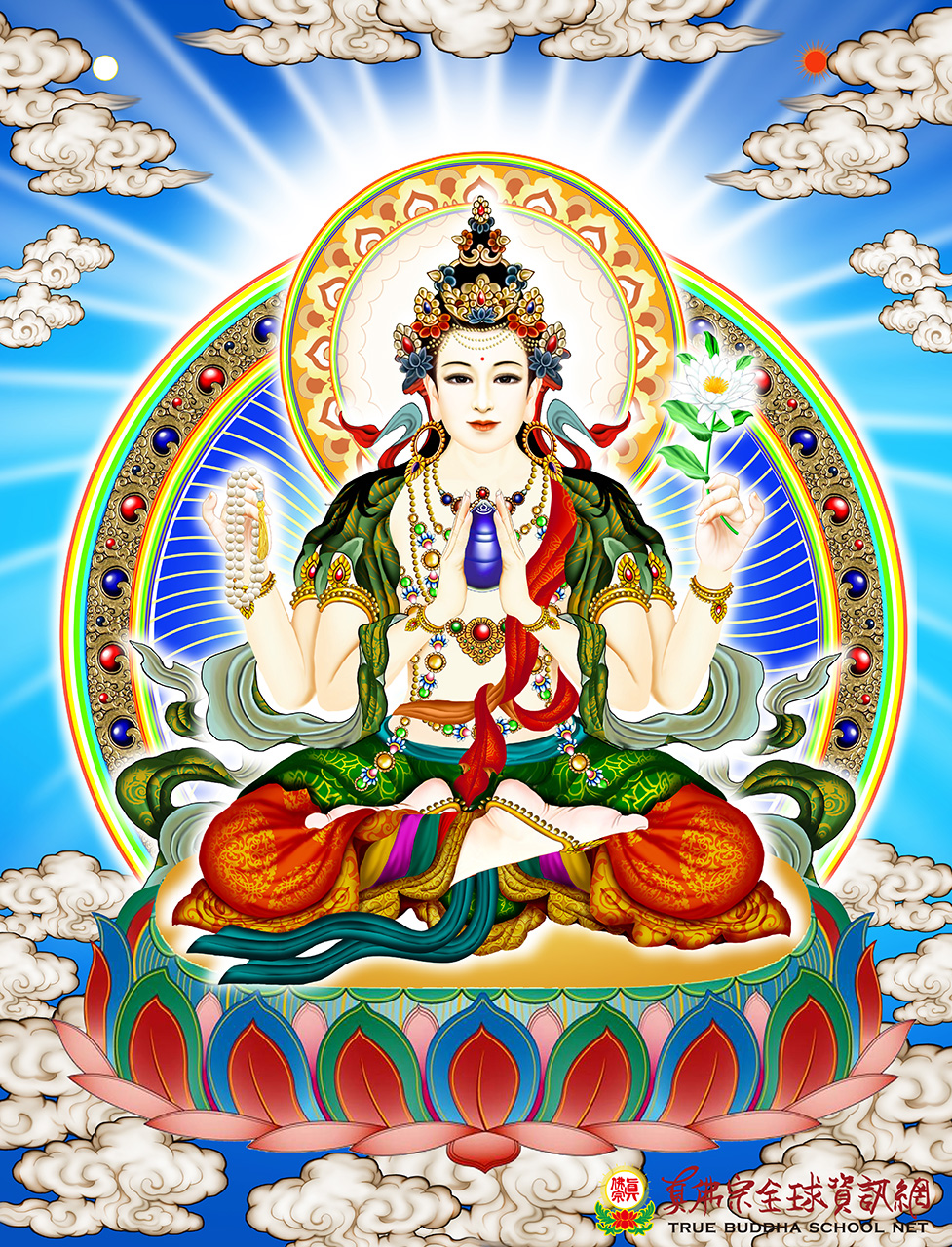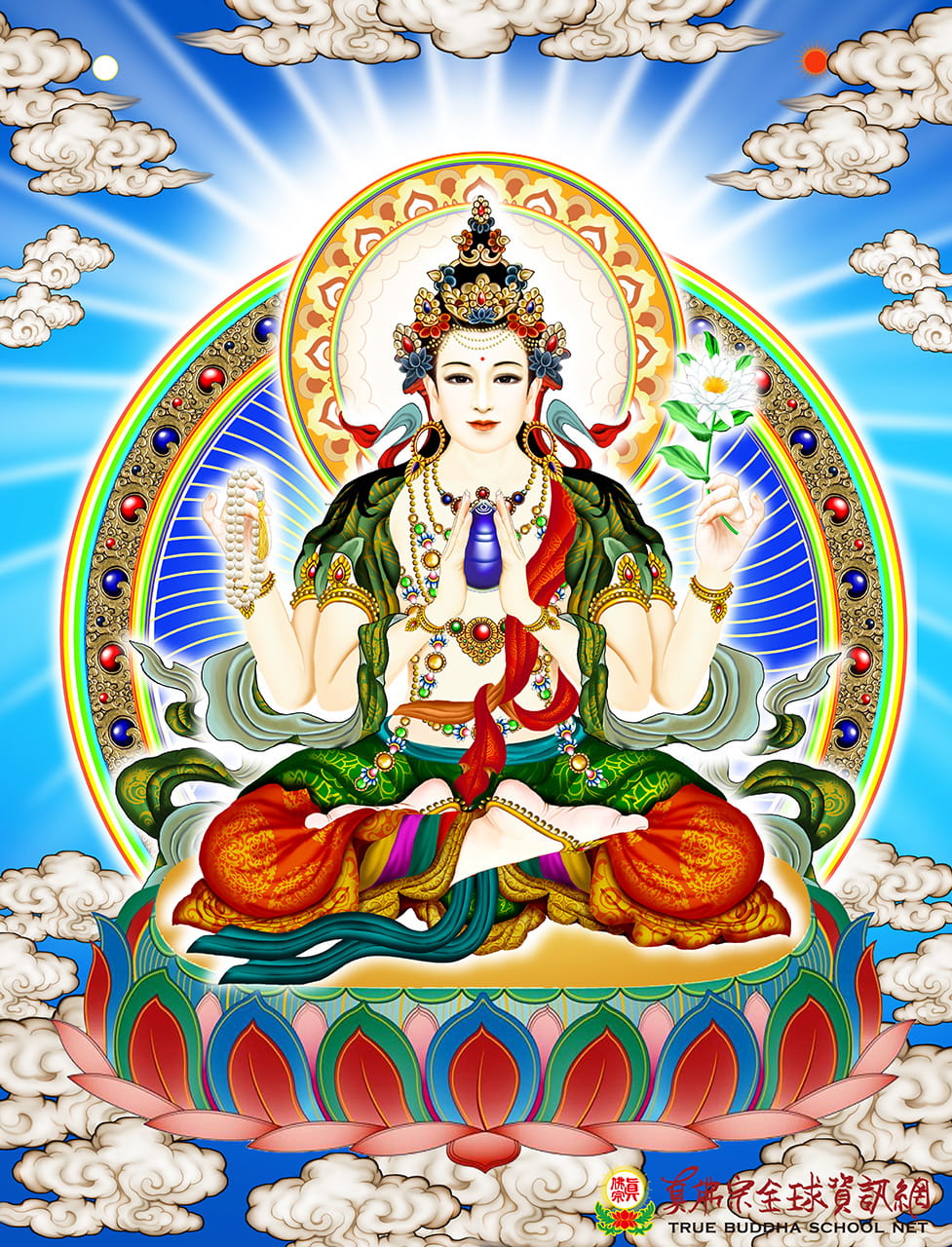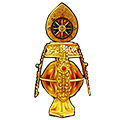On Sunday, Apr. 5, 2020, 3:00 PM, at Rainbow Temple, True Buddha School Dharma King Living Buddha Lian-sheng Sheng-yen Lu will preside over a homa ceremony for two principal deities, Four-armed Avalokitesvara and Ksitigarbha Bodhisattva, and discourse Lamdre. (Live Webcast Link: https://www.youtube.com/channel/UCLl20r-KQlapX_5fT-N3cOw)
【Four-armed Avalokitesvara Mudra (Lotus Mudra) :】
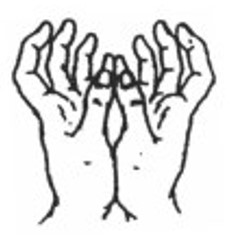
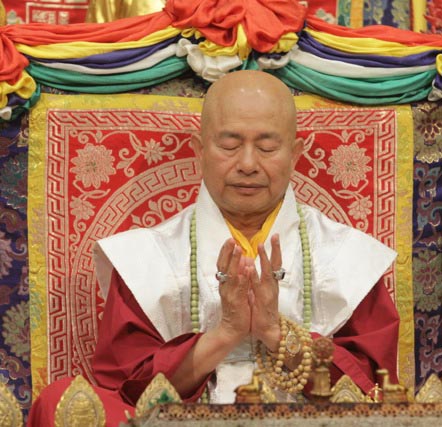
Place the palms together. Open the palms like a flower in bloom while keeping the tips of the thumbs and the little fingers touching, and the base of the palms together. Place the mudra in front of the chest.
【Four-armed Avalokitesvara Seed Syllable :】

【Four-armed Avalokitesvara Mantra :】
「Om-ma-ni-pad-me-hum。」
【Four-armed Avalokitesvara Dharmalaksana Brief Introduction】
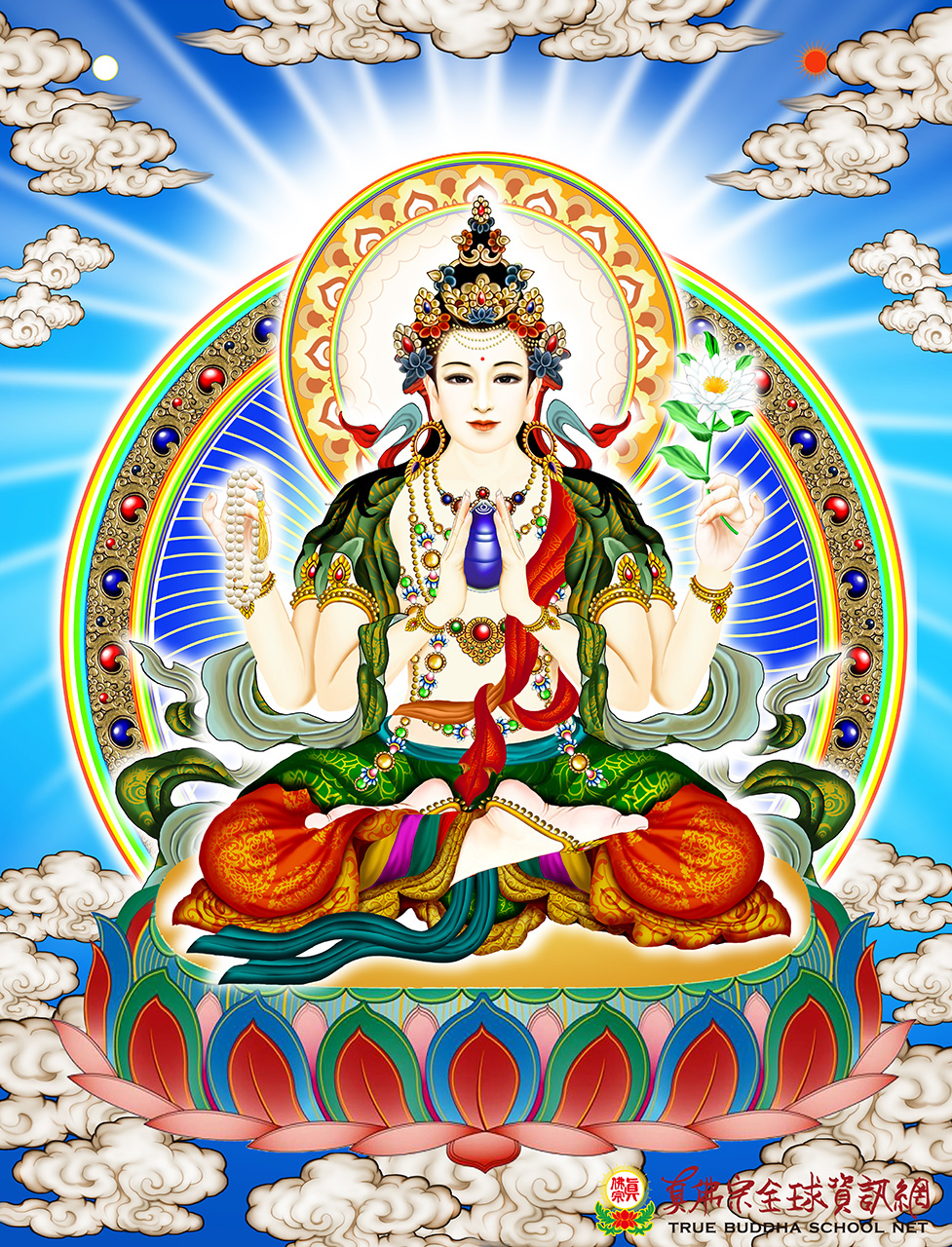
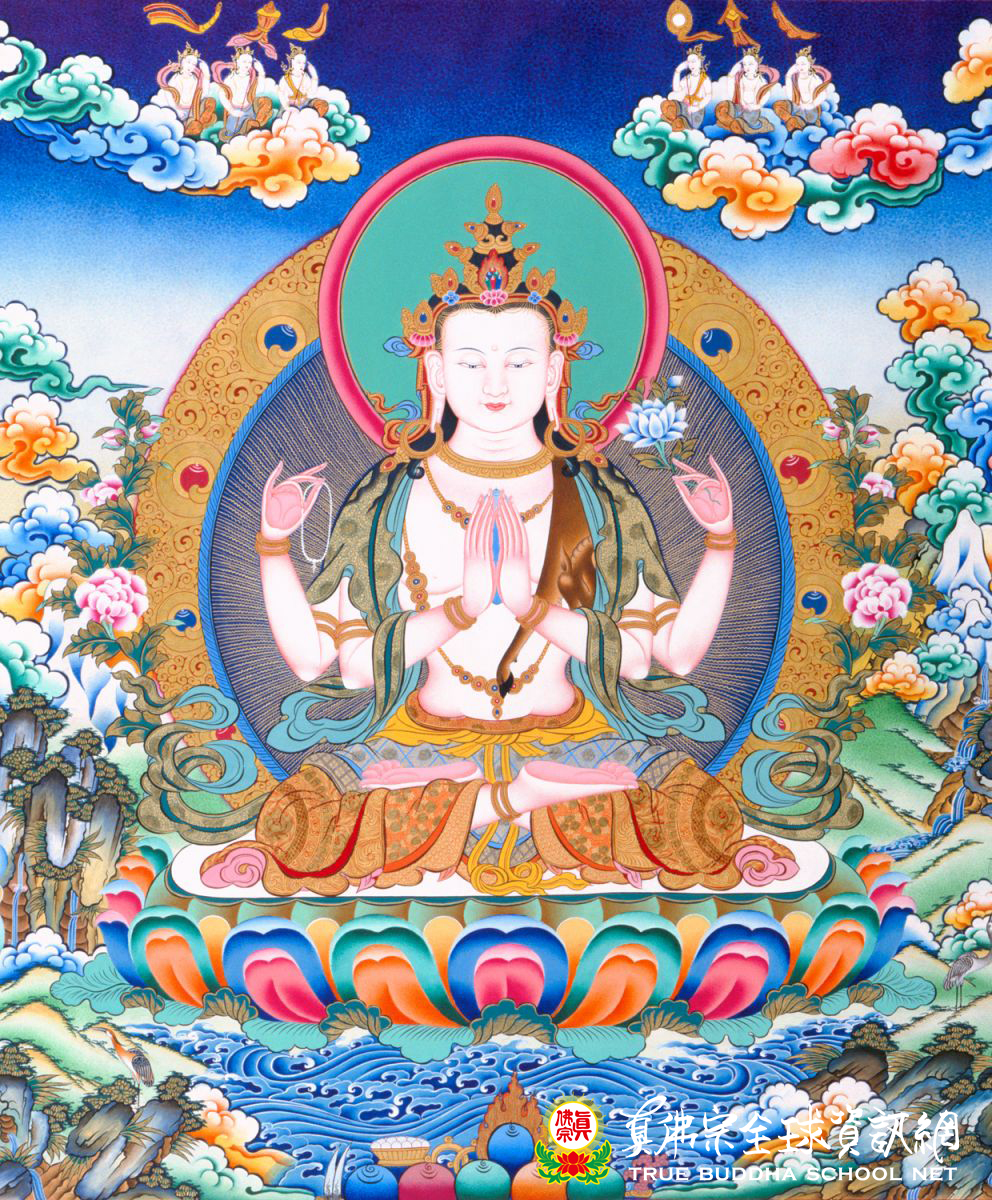
Four-armed Avalokitesvara clasps a mani jewel in his hands. This mani jewel is able to bestow treasure to all sentient beings. It manifests unlimited treasures for sentient beings and fulfills all their wishes and desires.
Four-armed Avalokitesvara wears a jeweled crown, sits in the full lotus position, is clothed in celestial garments and a silk skirt, and emits orbs of rainbow light in all directions. Avalokitesvara's upper hands clasp a mani jewel, the lower right hand holds a mala made of crystal beads, and the lower left hand holds a white lotus. The adornments of Four-armed Avalokitesvara are complete and perfect in every way.
The lotus held in the left hand symbolizes purity, while the mala beads held in the right hand symbolize diligence.
【Living Buddha Lian-sheng Sheng-yen Lu Dharma Talk - Four-armed Avalokitesvara Background and Key Cultivation Formula】
In Tibet, everyone knows of Four-armed Avalokitesvara and the Four-armed Avalokitesvara Mantra. Tibetans consider Four-armed Avalokitesvara to be the protector of Tibet. Even the highest living buddhas in Tibet are believed to be emanations of Four-armed Avalokitesvara. All Tibetans recite the great Six-syllable Mantra "Om, ma-ni, pad-me, hum". All the "mani stacks" in Tibet are engraved with "Om, ma-ni, pad-me, hum" in Tibetan. Chinese Buddhists recite "Namo Amitofo". Tibetan Buddhists recite "Om, ma-ni, pad-me, hum". Both mantras are equally revered.
Why are most cultivation venues in Tibet venues of Four-armed Avalokitesvara? Patriarch Tsongkhapa, the founder of the Gelug Sect of Tibetan Buddhism, was born in Huangzhong District of Qinghai Province, China. He studied Sutrayana and Vajrayana teachings extensively, authored countless scholarly works, and had eight close disciples.
In Vajrayana, a disciple whose relationship with his guru, in the guru's mind, is genuinely like father and son is called a "heart son", namely a son in Buddhadharma. Tsongkhapa's first heart son was Khedrup Je. He was the first to take refuge in Tsongkhapa and his subsequent reincarnations became the Panchen Lama.
Tsongkhapa's second heart son was Shakya Yeshe, who was received by the Emperor Yongle in the Ming Dynasty as Tsongkhapa's representative and had stayed by the emperor's side. He later reincarnated as Chankya Khutukhtu.
Grandmaster's lineage in the Gelug Sect is from Jetsun Dampa Kanjurwa Khutughtu to Thubten Nyima (Thubten Lama) to Thubten Dali to Thubten Dargye to Thubten Qimo. The split between Kanjurwa Khutughtu and Chankya Khutukhtu began with Jetsun Dampa. (Reference 'Guru Thubten Dargye' in Sheng-yen Lu corpus Book 197, Unveiling the Mandate of Heaven.)
Grandmaster is Thubten Qimo in the Gelug Sect lineage from Kanjurwa, Chankya, and Jetsun Dampa, who was the reincarnation of Shakya Yeshe, who was one of Tsongkhapa's middle disciples and travelled to the court of Emperor Yongle of the Ming Dynasty to represent Tsongkhapa. Because of this connection, Kanjurwa Khutughtu and Chankya Khutukhtu became linked to the landlocked Vajrayana.
Tsongkhapa's third heart son was Gedun Drupa, who took refuge in Tsongkhapa when Tsongkhapa was 57 years old. He was with Tsongkhapa for five years until Tsongkhapa entered parinirvana at the age of 63. Gedun Drupa later reincarnated as the Dalai Lama.
The Dalai Lama was Tsongkhapa's youngest disciple. The Panchen Lama was the oldest. The disciple in the middle was Chankya Khutukhtu. Because of the changing world, the Panchen Lama held religious power in the Tsang region of Tibet whereas the Dalai Lama were in the Anterior Tibet. As it eventually turned out, the Dalai Lama became prominent and the Panchen Lama was relegated to a secondary role.
It followed that Khedrup Je, reincarnated as the Panchen Lama, was Tsongkhapa's most senior disciple. This is an ever changing mandune world. In reality, as we know, the Panchen Lama was the transformation of Kalachakra and Amitabha Buddha.
Because of Four-armed Avalokitesvara's emanations including the Dalai Lama, all of Tibet is a cultivation venue of Four-armed Avalokitesvara, who saves the most sentient beings.
Four-armed Avalokitesvara is the primary deity of the Smoke Offering Practice transmitted by Living Buddha Lian-sheng. Due to the power of Avalokitesvara's vow of compassion, the wishes of Buddhist disciples can be perfectly fulfilled.
Regarding the Smoke Offering Practice, Dharma King Living Buddha Lian-sheng wrote in Book 202, Sightings From a Thousand Miles Away, that performing the Smoke Offering Practice results in the following benefits:
- Accumulation of merit. There is great merit in performing a fire offering. The merit of performing a smoke offering is also considerable.
- When one cultivates the Smoke Offering Practice, Four-armed Avalokitesvara must be the principal deity, and the cultivation is the equivalent of performing the Practice of Four-armed Avalokitesvara. As long as one attains spiritual union with Four-armed Avalokitesvara, one will attain spiritual union with buddhas, bodhisattvas, and Dharma protectors, and will definitely be reborn in the pure land.
I personally believe that visualization is of utmost importance in Vajrayana Buddhism. Visualization in Dharma protector practices can be exceedingly complex because of the visualization of the deities' many arms and Dharma implements. Four-armed Avalokitesvara Bodhisattva, however, is easy to visualize. One's visualization must be detailed and concentrated. Dharma power arises naturally from intense concentration.
Entering samadhi is entering the samadhi of Avalokitesvara. Avalokitesvara is the bodhisattva with the greatest compassion. Through this practice, one attains spiritual union with the "compassionate mind."
Four-armed Avalokitesvara Bodhisattva Practice
!!Please be aware that before engaging in any True Buddha Vajrayana practices, one must first take refuge and receive the respective empowerment.!!
⓪Please check the True Buddha School website regularly for the latest news about Living Buddha Lian-sheng and "be with Buddha" always.
Official True Buddha School Net (TBSN):
Home page: http://tbsn.org/
Indonesia Home Page: http://tbsn.org/indonesia/
Official Facebook Pages:
Chinese: https://www.facebook.com/syltbsn
English: https://www.facebook.com/syltbsnenglish
Indonesia: https://www.facebook.com/syltbsnindonesia
⓪Welcome fans (Vajra Dharma Protectors) of the Official English True Buddha Facebook site to invite their friends to join the Fan Club. Better yet, click "Like" and "Share". Let us together spread the name of Dharma King Living Buddha Lian-sheng to every corner of the world!!

